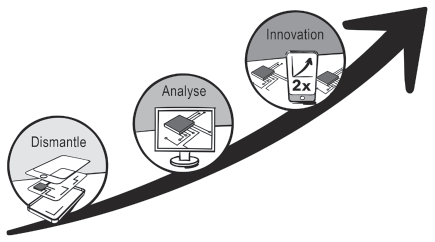Reverse Engineering
Taking lessons from competitors

The pattern
In the Reverse Engineering business model, an existing technology or competitor’s product is analysed, and the information obtained is used to develop a similar or compatible product (HOW?). Since this requires little investment in research and development, the products can be offered at a lower price than their market equivalents (VALUE?). Reverse Engineering is not limited to products or services: for example, it can also be applied to whole business models, when competitors’ value chains are analysed, and their principles applied in the focal company.

The advantage of such imitation is being able to forego superfluous features, replace expensive materials with cheaper components and bring established successful products to new customer segments that would not want or could not afford the expensive original products. By dint of learning from the pioneers’ mistakes and experiences, imitations frequently have the potential to be as good as the original (WHAT?). The primary aim is not to attain ‘first-mover advantages’, but to optimise existing products.
Because such imitations might infringe the original inventors’ and developers’ intellectual property rights, it is paramount to have a full grasp of patents and licences in order to be sure of staying within the bounds of the law and avoiding time-consuming and costly litigation (HOW?). It is also important to keep an eye on patent expiration dates, since imitations of goods based on expired patents cannot be attacked by the initial patent holders.
The origins
Reverse Engineering was primarily used in military contexts and, in the narrower sense of the term, applied for the first time during the First and Second World Wars. At this time, rapid technological progress made it a strategic necessity to understand enemy troop armaments and transportation systems. Reverse Engineering was frequently used to learn from acquired or stolen enemy equipment and make this information available to one’s own armed forces. After the Second World War, researchers in the German Democratic Republic took a similar approach in trying to reconstruct and copy certain computer and hardware technologies.
Within the automotive industry, Japanese manufacturers such as Toyota and Nissan bought and systematically analysed Western cars in order to learn how to build high-quality vehicles. Each car was disassembled, and its components analysed in respect of their functionalities, structures and characteristics. This is how the Japanese car industry began to imitate Western industry in the 1970s and 1980s. Since learning and improving was in the DNA of the culture, using systematic methods such as ‘Kaizen’ and quality circles, Toyota and other companies were able to outstrip Western industry.
Reverse Engineering: the process

The innovators
Pelikan is a Swiss-incorporated manufacturer of fountain pens, ballpoint pens, paper, arts materials, printer accessories and office equipment that made use of the Reverse Engineering concept. In the early 1990s, the company began manufacturing ink cartridges in imitation of models for popular printers and selling them at very competitive prices. This was made possible because Pelikan did not have to commit to substantial research and development costs, or cross-subsidise low-cost printers. The cartridges offered a similar quality to the branded products, thus presenting an attractive option to customers, and the competitive pricing strategy boosted sales and increased revenue for Pelikan.
Switching the focus to China, a very successful company applying the Reverse Engineering pattern is the technology firm Xiaomi. While industry rivals such as the chief design officer of global technology titan Apple, Jony Ive, describe their business activities as ‘theft’, this casts a false light on Xiaomi’s activities. Although several aspects of its products are very similar to competitors’ offerings, such as Apple’s, the company uses the Reverse Engineering approach to add attractive products that incorporate its own ideas in its distinct company’s tech ecosystem, resulting in close to 119 million smartphones sold in 2018.
Famous and highly successful for Reverse Engineering in multiple business occasions are firms created by the Berlin-based company builder Rocket Internet. Founded and led by the Samwer brothers, who belong among Europe’s most successful entrepreneurs, one of these reverse-engineered companies is the e-Commerce heavyweight Zalando. Created as a clone of US-based retailer Zappos, Zalando proves that Reverse Engineering can also be applied to whole business models. Writing a constant growth story, the firm showed €5.4 billion revenues in 2018 while leading the field of German online shops, followed by other highly respectable companies such as Otto and Amazon.
When and how to apply Reverse Engineering
Companies in the automotive, pharmaceutical and software industries make frequent use of this pattern. Reverse Engineering’s appeal and numerous benefits are often surprisingly intuitive. Some of these include cutting costs and reducing the time required for R&D activities, acquiring knowledge and know-how for products that have already been proven on the market, and recreating products whose manufacturers or documentation no longer exist. The use of 3D scanning and printing are instrumental in the spread of Reverse Engineering practices. When applying this pattern, it ought to be kept in mind that learning is more important than simply copying.
Some questions to ask
- What can we learn from successful practices in our industry and leading practices in other industries?
- How can we get legal access to our competitors’ products?
- Where can we learn the most?
- How can we learn about product functionality and cost leadership from leaders?
- How do we deal with voices in the public that are critical of Reverse Engineering practices?
- Will we be able to navigate the sometimes-tricky legal waters that companies engaging in Reverse Engineering often face?
- How can we translate and implement what we learn into our products and our company?
